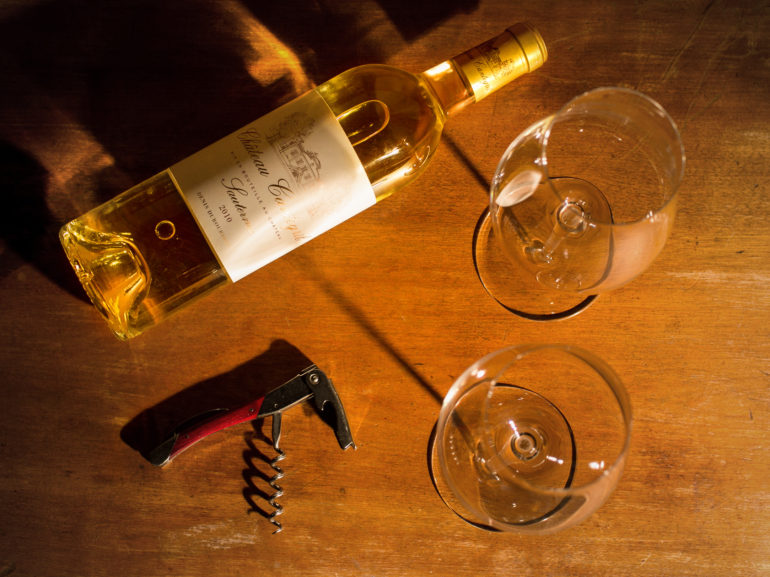What are late harvest wines?
Late harvest wines are made from grapes that are left on the vine even after they’ve reached their peak ripeness. When grapes are (quite literally) left hanging, they become sweeter over time as each individual grape dehydrates and the sugar content becomes more concentrated.
Late harvest grapes (typically picked 1-2 months after the regular harvest time) are used to make a wine that contains both higher residual sugar and higher potential alcohol than standard table wines. Technically, any wine grape can be harvested late (Chardonnay, Syrah, Pinot Gris, etc.), but you’ll tend to see certain grapes chosen over others due to their ability to process exceptionally high-quality late harvest wines.
Here are 4 exceptional grape varieties used for late harvest wines that are well worth seeking out.
Late Harvest Wines
Serving late harvest wines
Most late harvest wines are served cold, around 45–55ºF (7–13ºC), and poured in 2.5–3 oz. (75–90 ml) portions and served in small dessert wine glasses. If you do not have dessert wine glasses, simply use white wine glasses instead.
Riesling
Riesling is one of the most popular varieties used to produce late harvest wines. It’s an ideal grape for this style of wine because of its naturally high acidity (grapes lose acidity as they hang on the vine). The very best late harvest Riesling wines come from cool climates (where fall temperatures drop quickly), including Germany, Northern France, New Zealand, and Washington State.
- Tasting Notes: Aromas of apricot, honey, candied lemon, ginger, and jasmine. On the palate, the wine is sweet, with tingling acidity that highlights lemony notes on the finish.
- Pairing Recommendation: Try a late harvest Riesling with lemon cream pie or lemon pound cake.
In Germany, late-harvest Riesling is labeled as Spätlese (“spate-lay-say”) and above in the Pradikat classification system. For sweet wines, you’ll be particularly pleased with Beerenauslese Riesling which is commonly sold in half bottles.
In France, you’ll find late harvest Riesling in Alsace labeled as “vendage tardive” (or VT). The wine is quite rare but well worth a taste.
In the United States, producers in New York and Washington have an ideal cold fall climate for producing late harvest Riesling; this is a great place to look for this style, but you’ll also find great bottles coming from New York.
Vidal Blanc
Vidal Blanc (or simply Vidal) is a special grape variety that is a hybrid species of European grapes crossed with American ones (everyone loves a mutt). The result of this crossing is a very cold-hardy white grape that makes stupendous late harvest wines. Because of the vine’s weather tolerance, the grapes are often left on the vine to suffer through winter’s first freeze and are later used to produce outstanding ice wines. You’ll find Vidal Blanc widespread across the United States (from upstate New York to Minnesota) and it is also a very important variety in Canada.
- Tasting Notes: Intense aromas of dried pear, vanilla, beeswax, and orange marmalade. Wines taste rich and concentrated, exhibiting crisp flavors of orange peel on the finish.
- Pairing Recommendation: Try late harvest Vidal Blanc with apricot macaroons or a nutty cheese, such as Comté.
In Canada, the winters are cold enough to freeze grapes consistently to produce the even more precious ice wine. The world’s largest producer of ice wines, called Inniskillin, is located in Ontario.
In New York and several states in the Northeast, you’ll find excellent examples of late harvest Vidal Blanc coming from small producers.
Sauternais
Sauternais is a wine style named after a region in Bordeaux called Sauternes (“Soh-tern”), which is a blend of mostly Sauvignon Blanc and Sémillon grapes. The secret to the Sauternes region is its proximity to a particularly foggy section of the Garonne river. The fog engulfs the vineyards and causes the grapes to be infected with a necrotrophic fruit fungus called Botrytis cinerea (aka “noble rot”). Despite how icky the grapes look, the mold actually sweetens the grapes and makes for a dessert wine with exceptionally high sweetness.
- Tasting Notes: Lemon curd, honey, pineapple, and almonds.
- Pairing Recommendation: Try Sauternes with vanilla pot de creme, foie gras, a washed-rind cheese, or a soft, nutty cheese such as Muenster.

How is rot “noble?”
Find out more about the special gray mold that’s actually desired for its effect on certain grapes.
They Call it “Noble Rot.”
Muscat
One of the oldest families of grapes in the world is the Muscat family, which contains several varieties that are used to make both white and red wines. While there are many different grapes included in this family, the aromas from a Muscat variety (red or white) are unmistakable and highly perfumed. Muscat wines are made in a wide range of styles, but one of the most precious are the late harvest wines that are made by several different methods around the world.
- Tasting Notes: Mandarin orange, orange blossoms, roses, apricots, and nuts.
- Pairing Recommendation: Try a late harvest muscat with almond biscotti.
In Italy, the passito style of wine called Vin Santo (or Vino Santo) takes as long as 4 years to ferment into wine because it’s so sweet.
In the United States, you’ll find a few notable producers using the rare grape Orange Muscat to produce wines with strong orange aromas.
In Greece, on the small island of Samos, you’ll find Muscat of Samos, which is made in a floral and minerally style that ranges from dry to sweet.
In Australia, the rare Rutherglen Muscat can reach some of the highest sweetness levels found in wine.
Dessert Wine Guide
Dessert wines come in many styles, shapes, and sizes. Learn more about the major types of dessert wine in this dessert wine guide.
Dessert Wine 101

